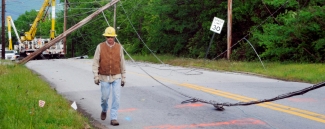There are necessarily high standards for operational and maintenance safety in power systems. By keeping systems running smoothly, utilities and grids can increase their reliability, reduce electrical risks, and protect staff and consumers from hazards. To do so, power systems must consistently prepare and implement safety measures, risk mitigation plans, standard operating procedures and emergency response plans.
PEER certification can help projects assess their existing safety measures and ensure that better maintenance practices, precautionary measures and continual improvement processes are implemented to create a safe working environment for everyone.
Check out some of the ways PEER-certified projects improve operational safety:
1. PEER-certified projects identify potential risks and develop mitigation strategies.
A power distribution system typically comprises several subsystems, parts of which can become vulnerable to threats and lead to system failure. To get ahead of these threats, PEER projects conduct a thorough assessment of their full power system and its potential risks, developing accurate mitigation strategies that reduce operational failures and accidents.
Key PEER credit: OP credit: Risk Assessment and Mitigation.
2. PEER-certified projects create an emergency response plan for staff and customers to implement when needed.
A variety of scenarios can cause power disturbances. An emergency response plan with detailed standard operating procedures helps staff better prepare for and handle emergencies, restoring the power supply without causing major damage or losses to the community.
Key PEER credit: OP credit: Emergency Response Planning.
3. PEER-certified projects prioritize a safe working environment for staff through recurring safety review programs.
Power systems have the potential to cause harm to the staff and public who interact with them. As such, it is vital to guide responses to failures, maintenance issues, and equipment operations to reduce risks and prepare staff for the worst.
Key PEER credit: OP credit: Safety Review Process
4 PEER-certified projects implement preventive and predictive maintenance programs.
Preventive and predictive maintenance programs reduce the unnecessary costs incurred during the operations and maintenance of a particular system. A formal failure identification and elimination process reduces equipment failures and risks to operational safety.
Key PEER credit: OP credit: Operational Processes.
5. PEER-certified projects implement cybersecurity and data privacy policies to protect their smart grid technologies and ensure the confidentiality of customer data.
Digital infrastructure, two-way communication and equipment controls are essential to grid modernization, but they also add complexity, interdependencies and vulnerabilities. Protecting these systems and consumers’ data from attack helps build public confidence in grid modernization.
Key PEER credit: GS credit: Data Privacy and Cybersecurity.
PEER is here to help power systems prepare for the challenges and opportunities of the 21st century. See if your project could be a good fit.
